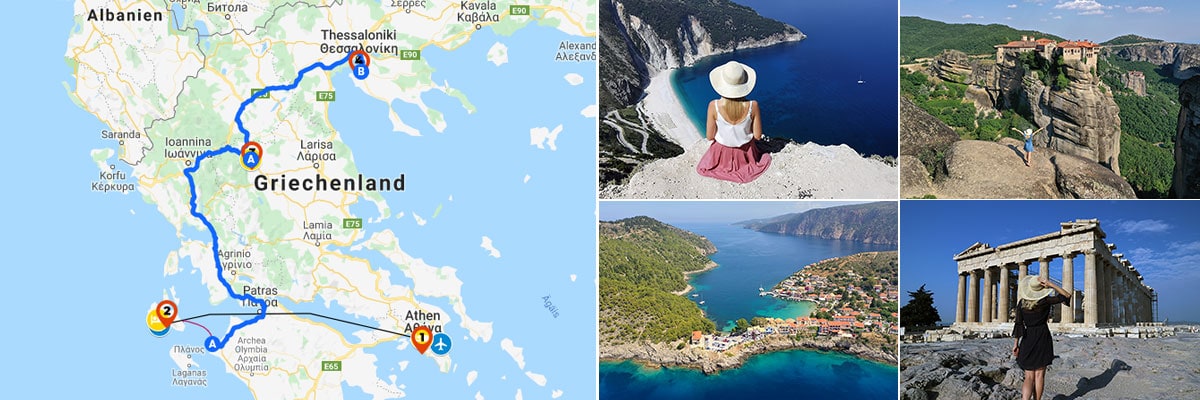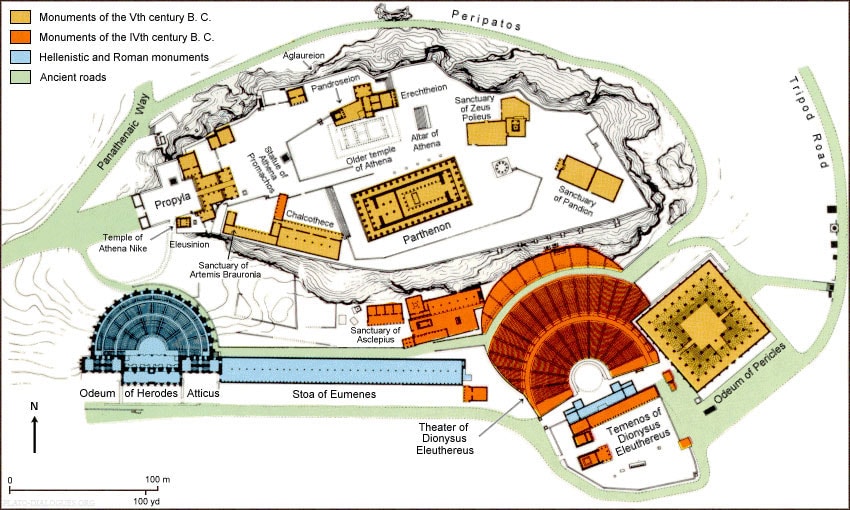She has been on our bucket list for a long time and we have been looking forward to the moment when we would finally see it: the Acropolis of Athens.

Table of contents
Things to know about the Acropolis
The Acropolis is actually the castle hill belonging to an ancient Greek city. The Athens Acropolis is probably the best known example of an acropolis, which is why the entire terrain is often referred to only as “The Acropolis” for simplicity. The Acropolis has dominated the cityscape of Athens for about 3,000 years and has been a UNESCO World Heritage Sitesince 1986.
The history of the Acropolis
The castle hill of Athens has a very long history, because it was already inhabited in the Stone Age. In the Mycenaean period, there was a palace of lords, around 500 B. Chr. temples were built here, the gods replaced the earthly rulers. A few years later, the Persians conquered Athens and destroyed the seat of these gods. With the debris, among others the perimeter walls were fortified, other pieces were used in the newly built temples.
The most important construction phase of the Acropolis was between 467 and 406 BC, when the Propylae, the Parthenon Temple, the Erechtheion and the Nike Temple were built on a flat, 156-metre-high rock. In the following years, monuments were mainly added. After Christianity had established itself, the Parthenon was converted into a church, smaller temples became chapels and on the Acropolis bishops resided instead of Greek priests. After the conquest by the Turks came the next change: the Parthenon became a mosque, the Erechtheion became the harem.
In 1687 everything changed: in order to expel the Ottomans, a Venetian commander had the Acropolis shelled, which led to an explosion of a powder magazine in the Parthenon and severely damaged the temple and other buildings. Further destruction occurred around 1800, when the Englishman Lord Elgin robbed numerous sculptures and brought them to England. It is thanks to the Greek King Otto that the Acropolis was placed under the protection of the state as an archaeological site and that it was to appear again as a national monument in its old form. Therefore, the Byzantine and Ottoman buildings were demolished.
Due to incorrect renovations in the first years, corrosion and pollution, the ancient buildings have suffered greatly and are being restored almost permanently. Therefore, the Acropolis today resembles a large construction site rather than a temple complex – it is almost impossible to see the castle hill without a crane. We were very lucky because we were on a holiday on the Acropolis and the construction work on that day stood still 🙂
The best view of the Acropolis in Athens
Due to the elevated location of the Acropolis 156 meters above the city,one actually has a great view of the world heritage from almost everywhere. Nevertheless, there are some special viewpoints that we would like to introduce to you.
City mountain Lykavittos: The 277-metre-high mountain is the highest peak in the centre of Athens and offers magnificent views of the Acropolis and the Parthenon. The mountain can be reached either on foot or by a funicular, the station of which is located in the street of Od’s Aristoppou.
Rooftop Bars: Many hotels in Athens have a Rooftop Bar from where you can see the Acropolis. We haven’t visited a Rooftop Bar ourselves, but one of the best views is from the Hotel A for Athens, as you still have the great scenery of Monastiraki Square in the foreground. Even from our hotel The Stanley we had a very good view of the Acropolis, albeit a little further away. We have found more recommendations for beautiful Rooftop Bars at Lonely Planet.
Philopapposmonument: Another viewpoint is located on the 147 meter high MusenHill (Philopappos Hill) southwest of the Acropolis of Athens. The hill was named after a monument erected at the top of the hill in honor of the Roman senator Philopappos.
Entrances, opening hours & ticket prices
The Acropolis is open daily from 8 a.m. to 8 p.m., with a few exceptions. On some days, admission is even free (e.g. on 06.03., 18.04., 18.05.). It is best to keep up-to-date on the official website of the Ministry of Culture.
The Acropolis is visited by thousands of people every day. So if you want to have beautiful photos of the Acropolis and its buildings, where there are not hundreds of people on it, you have to get up very early. We were about 30 minutes before the opening at 8 o’clock at the entrance gate on Dionysiou Areopagitou street.
There are three different accesses to the Acropolis:
1) Metro station Acropolis, then over the Dionysiou Areopagitou street (Google Maps)
2) Metro station Acropolis, then through the archaeological site South Slope, Dionysiou Areopagitou & Thrasyllou street (Google Maps)
3) Metro station Monastiraki, then through the archaeological site Ancient Agora or over the district of Plaka
Here at the entrance gate two different snakes formed early on. On the left were those who already had tickets (like us) and on the right in front of the cashier’s house the people who still needed tickets. We recommend that you get tickets in advance. For example, this can be easily done online via the official ticket page.
A ticket for the Acropolis costs 20 EUR per person. We recommend buying a combined ticket directly for 30 EUR, which is valid for 5 days. This combined ticket includes several other cultural sites in Athens, such as Ancient Agora, Hadrian’s Library, North slope of the Acropolis, Olympieion, Roman Agora and South Slope of Acropolis.
The iVenture Card Athens
For Athens there are several tourist maps,with which you get free, preferred or discounted admission to the attractions or museums.
For the city exploration of Athens we had the 1 Day Athens Unlimited Attractions Pass from iVenture. This one-day ticket costs around 71 EUR online. However, it should be noted that this is only worthwhile if you also use several offers of the card. And you have to keep in mind that the card is only valid on the day you buy it or use it for the first time!
We had used our card for admission to the Acropolis (20 EUR), the Panathinaiko Stadium (5 EUR), the Hop-On-Hop-Off Bus from Athens Open Tour (26 EUR) and a full dinner at Hard Rock Café Athens (28 EUR). We would have liked to have visited the Acropolis Museum (10 EUR), but unfortunately we did not manage this in time. In total, we used the day ticket to charge 79 euros. Unfortunately, some attractions, such as the Agora with the Temple of Hephaistos or the Temple of Zeus (Olympieion), are not allowed on the card and have to pay extra for these entrance fees. So you should calculate carefully whether such a card is really worth it.
A Plan of the Acropolis
The following image illustrates the original reconstruction of the Acropolis with all its structures. We couldn’t find a plan from today’s point of view and we didn’t get one when we visited the Acropolis. But since everything is very centrally located, you can find your way around quite well even without a map. Otherwise you can look at the side of Wikivoyage.com again. There is also a detailed plan with the individual buildings.
A tour of the Acropolis
After the entrance gates of the Acropolis had opened at 8 o’clock in the morning, we quickly walked up to the rocky plateau in a hurry to be able to take pictures without other tourists. This was actually possible for a few minutes, but within a very short time the temple complex was full. We have really rarely seen sooo many tourists in a spot at a sight. Really crazy!
The Propylae
As we walked up the way from the cash register, we first reached the Propyläen at the western entrance. These form the main entrance or gate to the Acropolis of Athens. A marble staircase leads up to the gatehouse of the Propylae, whose entrance is adorned by six columns. On the right side of the Propyläen is a rock with the Athena Nike Temple. You have to walk through the Propylaeto to get to the plateau of the Acropolis and explore the wider terrain.
The Parthenon
And then we finally stood in front of it – in front of THE landmark of Athens, which is certainly one of the most famous buildings in the world 🙂 If we always had a picture of the Acropolis in our minds, it was usually the Parthenon that was emblematic of the Acropolis for us. And yet it is only part of the whole facility.
The Parthenon, about 70 metres long and 30 metres wide, is dedicated to the goddess of protection of the city of Athens, Pallas Athena Parthenos. It is certainly one of the most famous still existing monuments of ancient Greece, which has dominated the Athens Castle Hill for almost 2,500 years.
The Erechtheion
Also on the upper plateau is the Erechtheion, which is mainly known for its small porch, which is carried by six larger-than-life girl figures (also known as caryatides). In order to protect the figures from weather influences, they were replaced by replicas at the end of the 20th century. The originals are now on display in the Acropolis Museum.
More impressions of the Acropolis
On the grounds of the Acropolis you will also find the Odeon of Herod Atticus – an ancient theatre with space for up to 5,000 spectators. Also great are the views from the Acropolis over the city, which you have in all directions. A little in the distance you can still see on the Muse Hill the Philopapposmonument, which was erected in honor of Gaius Iulius Antiochus Epiphanes Philopappus as well as the viewpoint Areopagus Hill.
Just 30 minutes later, things looked very different. Then slowly come the guided tours, especially from the cruise ships. Then it gets very crowded up here and on the paths very quickly! We had read that this relaxed a bit in the late afternoon. But here are a few pictures to get an impression of how full it can get up there.
Starbucks Global Icon City Mug of Athens
We are collecting the Starbucks Mugs from the cities and islands we visit on our travels. Unfortunately, not every city that has a Starbucks store with an own mug. But if the city has an own mug we like to collect them as a souvenir. We only collect city mugs from the "Global Icon Series", which was released in 2008. You can see our complete collection here: Starbucks - Our collection of Mugs from the Global Icon SeriesAthens has several Starbucks stores and also its own cup 🙂
All travelogues from Greece 2019
After we were able to get to know the islands of Mykonos, Santorini, Milos and Crete last year on a Cyclades cruise with Celestyal Cruises, this year we also wanted to explore the mainland of Greece. As a result, with Discover Greece we have put together a beautiful round trip that connects Athens, the island of Kefalonia and the monasteries of Meteora. Since Athens and the monasteries of Meteora have been on our bucket list for a long time, we were really looking forward to this trip.
» Day 1: Our travel plans for Athens, Kefalonia & Meteora (Greece)
» Day 2: The Acropolis – The landmark of Athens (Greece)
» Day 3: Athens – Tourist Attractions, Things to do & Photo spots (Greece)
» Day 4: Argostoli – The capital of the island of Kefalonia (Greece)
» Day 4: Kefalonia – Tourist Attractions, Things to do & Photo spots (Greece)
» Day 5: Meteora – How to get there, Hotel & Sunset Tour (Greece)
» Day 6: The monasteries of Meteora – a UNESCO World Heritage Site (Greece)





